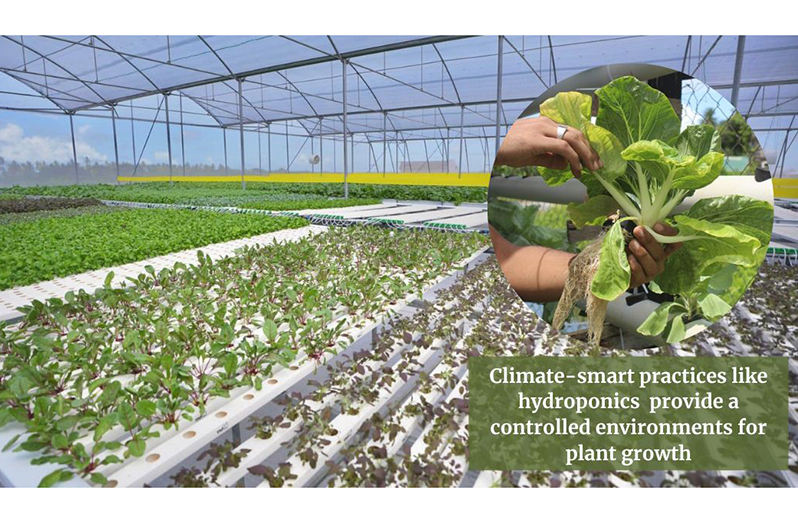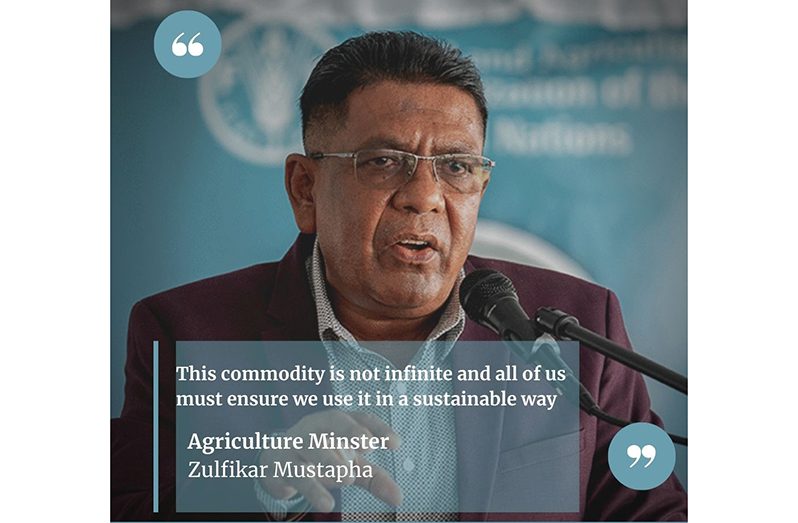WATER scarcity is threatening food security in the America’s and according to regional agriculture officials, if action is not taken at the policy level swiftly, food production could decrease severely.
In Guyana, however, efforts have begun to introduce climate smart practices to farmers to bolster this emerging threat to food production.
The country’s Agriculture Minister, Zulfikar Mustapha at recent event held to commemorate World Food Day, revealed that climate smart practices such as drip irrigation and water harvesting is being introduced to farmers.
 “The Ministry of Agriculture has been proactive in dealing with the potential challenges for agriculture on our water resources. The ministry has undertaken several initiatives to promote sustainable water use and management for agriculture,” he said.
“The Ministry of Agriculture has been proactive in dealing with the potential challenges for agriculture on our water resources. The ministry has undertaken several initiatives to promote sustainable water use and management for agriculture,” he said.
While these measures were introduced to bolster the effects of the El Nino weather pattern, the intent is to have long term solutions.
Drip irrigation is among some of the solutions; it is a type of micro-irrigation that reduces water wastage by delivering water directly to the root zone of the crops. This can either be done above the soil surface or buried below the surface.
Meanwhile, water harvesting is the collection and storage of rainwater, rather than allowing it to run off.
“These initiatives aim to improve irrigation practices on water efficiency and ensure the long-term viability of the agriculture sector,” the agriculture minister explained.
Another measure is mulching which is the process of adding a layer of material to the surface of soil to retain moisture.

Aside from these initiatives, Guyana’s Agriculture Ministry has invested in improving the drainage and irrigation infrastructure in the country. To this end, GY$26 billion has been expended in upgrading the drainage and irrigation systems for the year 2023.
“This commodity [water] is not infinite and all of must ensure that we use it in a sustainable way.”
Further speaking on the issue of water scarcity and the effects of the extreme dry weather, Mr. Mustapha in an interview with this publication revealed that fresh water was being conserved to assist cash crop farmers.
“We are working together to monitor the situation. We are trying to maximise the use of water… I am hoping that with the plan we have, we will not run out of freshwater,” he said.
He maintained that the country has enough water to last through the dry spell.
In fact, water levels at a conservancy in the country currently stands at 56.60 GD and is satisfying the irrigation needs in farming area.

HOW DOES WATER SCARCITY THREATEN FOOD SECURITY?
The scarcity of water, its improper use and the impact of climate are seriously threatening agri-food systems, according to the Inter-American Institute for Co-operation on Agriculture (IICA) representative to Guyana, Wilmot Garnett.
Garnett, who also spoke at a recent event, shared that in order for food systems in the region to remain resilient, agriculture officials must develop and implement innovative production systems that prioritise water use.
If action is not taken, food production in the region could decline by more than 25 per cent by 2025, Garnett explained.
The demand for water could also increase.
“The growing demand for food due to changing consumption habits, the demand for water for energy production, the effects of climate change and the inefficient use of water management, if substantial changes are not made in agriculture colleagues, the demand for water for agriculture water use will increase between 70- 90 per cent by 2050,” the IICA representative said.
He believes water productivity and efficiency should be the focus now especially since the region has been pushing for more food production and within this conversation water security must be a pivotal topic.
“This is not an automatic process …this requires special policies, we need to have the political will and the incentives we need to ensure that we engage our users not only the farmers but users in general.”

Currently, agriculture accounts on average for 70 per cent of all freshwater withdrawals globally and an even higher share of consumptive water use.
Although Guyana has abundant fresh water, which is ideal for food production, changing weather patterns and the effects of climate change can pose a threat to the country’s agriculture sector, Food and Agriculture Representative FAO to Guyana, Dr. Gillian Smith said.
Dr. Smith, during a recent interview, shared, “In Guyana, different from many of the Caribbean countries there is quite a surplus of water but there are also times when there is no water and we are reminded of that.”
Further referencing the current weather condition in the country she said, “We are also in the middle of El Nino and one of the things that happen with El Nino is the patterns change dramatically and we experience more drought and this is an important time to remind us sometimes we have a lot of water and we also have to plan and be prepared for the times for when there is not so much.”

SMART AGRICULTURE, SMART PRACTICES
In promoting efficient water use and more climate smart practices in agriculture, both farmers and agriculture officials in Guyana have been pursuing the science of growing food with less water through hydroponics.
This a technique of growing plants using a water-based nutrient solution rather than soil.
With this technique plants can grow using less water than traditional field crop watering methods, Linden farmer, Winton Camacho, explained.
“Hydroponics and aquaponics are highly efficient in water usage compared to conventional soil-based farming. In hydroponics, plants are grown in a soilless medium and receive nutrient-rich water directly to their roots.”
Camacho, 23, studied aquaponics and hydroponics in Trinidad and Tobago and Australia.
In an interview with this publication, he explained that hydroponics and aquaponics play significant roles in combating water scarcity and promoting climate-smart practices.
These innovative farming methods he noted offers sustainable solutions to traditional agriculture, which often consumes large amounts of water and contributes to greenhouse gas emissions.
He explained that the closed-loop system used in hydroponics recirculates the water, resulting in significant water savings. Aquaponics, a similar technique to that of hydroponics, uses fish waste to provide nutrients to plants to conserve water.

This combines hydroponics with aquaculture, this integrated approach reduces water consumption by up to 90 per cent compared to traditional agriculture.
“Hydroponics and aquaponics offer year-round production and increased crop yields due to optimal growing conditions,” he said.
These methods he explained allows for local food production, reducing reliance on imported produce and enhancing food security by providing fresh, nutritious food consistently.
In fact he said: “By promoting water conservation, climate resilience, land optimisation, reduced environmental impact, and improved food security, hydroponics and aquaponics systems are valuable tools in combating water scarcity and implementing climate-smart practices.”
At the policy level here in Guyana, the government has embarked on a multi-million dollar project to promote hydroponics country wide.
Several shade houses and hydroponics farms have already been established. These projects are overseen mainly by youths and sees the production of high valued crops such as lettuce, carrots, cauliflower and other leafy vegetables.



.jpg)








